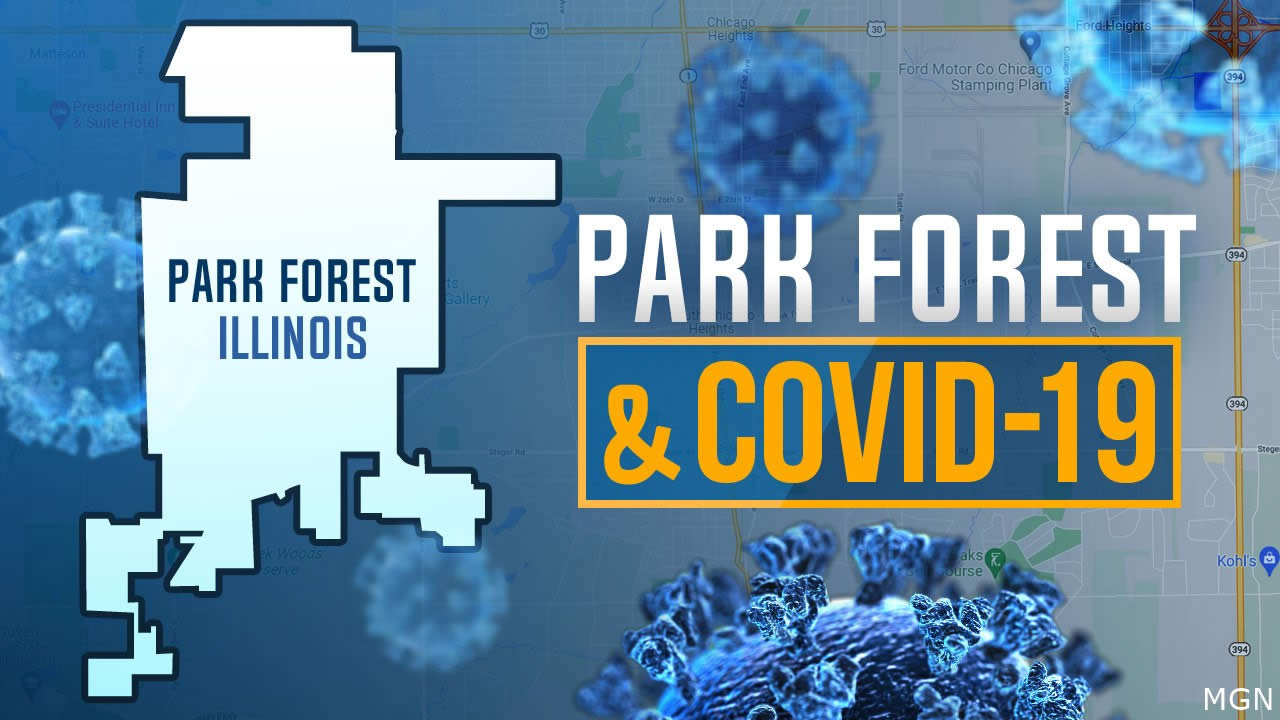
Park Forest, IL-(ENEWSPF)- Cicero is off the charts with cases of COVID-19 compared to the other towns eNews Park Forest tracks. In fact, as of this writing on May 25, Cicero continues to dominate the known number of cases in all of Cook County, distantly followed by Des Plaines, which has 1364 cases.
In the past, Cicero had a lower rate per 100,000 people because of its large population of almost 84,000 people. Now, Cicero easily has the highest rate of people per 100k among the towns we survey, and the fifth-highest rate in all of Cook County, at 2938.41.
Park Forest currently has 453 known cases of the disease that continues to keep us quarantined with a rate of 2113.96 per 100,000 people, the second-highest rate of the towns we survey and the ninth highest rate in all of Cook County.
According to the state of Illinois, Ludeman Center in Park Forest stull has 204 residents who tested positive for COVID-19. That figure is unchanged since we last tallied figures on May 23, 2020. A total of 111 of that 204 have recovered, according to Parents & Friends of Ludeman Center, and 196 tested negative, with 0 pending results.
A total of 119 staff members at Ludeman have tested positive. However, of these, 80 have recovered and returned to work. That last figure is up from May 17 when only 58 had recovered and returned to work. A full 98 employees have tested negative and were never infected.
Are you experiencing mental health issues related to COVID-19? Text “TALK” or “HABLAR” to 552020 to receive support from a counselor in your local community.
Ludeman Center employs 905 people and has 343 residents. All have been tested, some twice, according to Parents & Friends. Staff continues to undergo wellness checks before reporting to their respective assignments, the group Parents & Friends reports.
Eighteen (18) people from Park Forest have died of COVID-19 related issues according to the Cook County Medical Examiner‘s office. That is five more than our last tally.
A total of 2421 people in Park Forest have been tested with an overall positive test percentage of 18.71%, down from 19.82% when we last surveyed.
eNews Park Forest continues to track the number of cases and the rate per 100,000* cases for 30 municipalities in the South Suburbs.
The Will County Health Department reports 38 cases of COVID-19 in the Will County section of Park Forest as of May 22, 2020. Will County has not updated this total since our last tally.
As of this writing, Chicago Heights has 473 confirmed cases and a rate of 1562.29 per 100k. Steger has 67 cases, Flossmoor 75, Richton Park 189, Olympia Fields has 52, Sauk Village 103, Glenwood 155, Tinley Park 272, and South Chicago Heights has 70.
Harvey has 367 cases, Country Club Hills has 284 cases, Orland Park 401, Lynwood 113, Lansing 325, Homewood 255, South Holland 346, Markham 188, and Crete 128. Ford Heights now has 31 cases, and, for the first time, Calumet City tops the 500 mark with 504 and a rate of 1360.62 per 100,000 people.
Currently, IDPH is reporting a total of 112,017 cases, including 4,884 deaths, in 100 counties in Illinois. The age of cases ranges from younger than one to older than 100 years. Within the past 24 hours, laboratories have reported 21,643 specimens for a total of 769,564.
The statewide 7-day rolling positivity rate, May 16 – May 22 is 12%.
As of May 25, 2020, there are a total of 28,028 confirmed cases of COVID-19 in suburban Cook County and 1,191 deaths; 159 cases are in congregate settings, such as long term care facilities or nursing homes, are reporting one or more confirmed cases. Twenty-three cases are in other settings, such as workplaces or large gatherings, with confirmed outbreaks; with a total of 242 outbreak-associated cases.
The data from Cook County includes all cases under the jurisdiction of the Cook County Department of Public Health (excludes Chicago, Evanston, Oak Park, Skokie, and Stickney Township). All numbers are provisional and subject to change.
As of this writing, Will County now reports 5,012 confirmed cases and 257 deaths.
We must note: Other countries have fewer cases of COVID-19, far lower rates per 100k. The higher numbers are not an inevitability of testing. Testing alone is not the determining factor in higher numbers.
We leave further interpretation of the data up to our astute readers.
Deceased from COVID-19
The Cook County Medical Examiner reports 3,440 total COVID-19 related deaths since March 16, 2020, as of May 25, 2020.
As noted above, Park Forest has lost 18 people from COVID-19.
The number of deceased from Chicago Heights remains at 25, unchanged since we last tallied. Cicero lost 56, Richton Park 11, Matteson 20, and Country Club Hills 26. The number of deaths in Steger (Cook County) is 4, unchanged since we last tallied. Crestwood has lost 7, and Homewood has lost 26.
The City of Chicago has lost 1,948 people to COVID-19.
Current COVID-19 Cases for 30 South Suburban Towns
| Municipality | COVID-19 Cases | Most Recent Population Figures | Rate per 100,000 Population* |
| Calumet City | 504 | 37042 | 1360.62 |
| Chicago Heights | 473 | 30276 | 1562.29 |
| Cicero | 2465 | 83889 | 2938.41 |
| Country Club Hills | 284 | 16541 | 1716.95 |
| Crestwood | 89 | 10950 | 812.79 |
| Crete | 128 | 8117 | 1576.94 |
| Dolton | 319 | 23153 | 1377.79 |
| East Hazel Crest | 11 | 1543 | 712.90 |
| Flossmoor | 75 | 9464 | 792.48 |
| Ford Heights | 31 | 2763 | 1121.97 |
| Frankfort | 120 | 19178 | 625.72 |
| Glenwood | 155 | 8969 | 1728.17 |
| Harvey | 367 | 25282 | 1451.63 |
| Hazel Crest | 193 | 14100 | 1368.79 |
| Homewood | 255 | 19323 | 1319.67 |
| Lansing | 325 | 28331 | 1147.15 |
| Lynwood | 113 | 9007 | 1254.58 |
| Markham | 188 | 12508 | 1503.04 |
| Matteson | 323 | 19009 | 1699.20 |
| Oak Forest | 192 | 27962 | 686.65 |
| Olympia Fields | 52 | 4988 | 1042.50 |
| Orland Park | 401 | 56582 | 708.71 |
| Park Forest | 453 | 21429 | 2113.96 |
| Richton Park | 189 | 13646 | 1385.02 |
| Sauk Village | 103 | 10506 | 980.39 |
| South Chicago Heights | 70 | 4139 | 1691.23 |
| South Holland | 346 | 22030 | 1570.59 |
| Steger | 67 | 9331 | 718.04 |
| Tinley Park | 272 | 49235 | 552.45 |
| University Park | 104 | 6958 | 1494.68 |
| Combined | 8667 | 606251 | 1429.61 |
*Numbers per 100,000 based on most recent population from US Census.gov or derived via formulat using rate per 100,000 population and COVID-19 cases as reported by Cook County. |
|||
The following chart will auto-update as we update our Google spreadsheet:
This chart might not appear on all mobile devices. It does not appear, for example, in the browser built into the Apple Facebook app.
Overall for the State of Illinois
The Illinois Department of Public Health (IDPH) on May 25 announced 1,713 new cases of coronavirus disease (COVID-19) in Illinois, including 31 additional deaths.
- Cook County: 1 female 30, 1 male 30, 1 male 40s, 1 male 50s, 2 females 60s, 1 male 60s, 4 females 70s, 3 males 70s, 2 females 80s, 2 males 80s, 1 female 90s, 3 males 90s
- La Salle County: 2 male 60s
- Madison County: 1 male 70s
- McDonough County: 1 female 60s
- St. Clair County: 1 male 80s
- Union County: 1 female 50s, 1 female 90s
- Will County: 1 male 70s
- Winnebago County: 1 female 70s
Currently, IDPH is reporting a total of 112,017 cases, including 4,884 deaths, in 100 counties in Illinois. The age of cases ranges from younger than one to older than 100 years. Within the past 24 hours, laboratories have reported 21,643 specimens for a total of 769,564.
The statewide 7-day rolling positivity rate, May 16 – May 22 is 12%.
*All data are provisional and will change. In order to rapidly report COVID-19 information to the public, data are being reported in real-time. Information is constantly being entered into an electronic system and the number of cases and deaths can change as additional information is gathered. Information for deaths previously reported has changed, therefore, today’s numbers have been adjusted. For health questions about COVID-19, call the hotline at 1-800-889-3931 or email [email protected].
About the Elisabeth Ludeman Center
As of May 11, the Illinois Department of Human Services reports a current census of 344 residents at Ludeman Center. Of these:
- The average age is 53.2 years (22 – 77);
- 74% of the residents are severe and profound mentally, intellectually, and physically disabled.
- 48% are non-verbal, using sign language or gestures to communicate;
- 62% have a behavior intervention program, often requiring higher
levels of staff supervision; - 62% receive psychotropic medications.
The Elisabeth Ludeman Center occupies 60 acres in Park Forest at the southwest corner of Orchard Drive and North Street.
The Center is divided into three (3) residential units comprised of 13-14 homes. Each unit has a centrally located Neighborhood House which has offices for the Unit Director, Social Worker, Unit Physician, Nursing Personnel, Qualified Intellectual Disabilities Professionals, (QIDP’s), Residential Services Supervisors and clerical personnel. The Ludeman Center also serves as an admission center for individuals having significant adaptive issues in the community-based setting. The Interdisciplinary teams’ main priority is to stabilize and ensure a successful transition back into the community.
Each of the 40 ranch-style homes has a kitchen, dining/living room area, utility room which contains a washer and dryer, two full and one half bathrooms, and five bedrooms.
Approximately half of the people who currently reside at the Ludeman Center attend vocational training programs at community training sites or workshops. The remainder of the people are served in on-campus day training programs. Currently, several individuals are working in a food service program, housekeeping program, horticulture program (vegetable garden and greenhouse flowers) and in the Center-wide recycling program.
Finally, the Ludeman Center has opened its doors and shared space/services with the Illinois Department Of Transportation’s District 1 South DBE Resource Center; as well as the Office of the Inspector General, Bureau of Civil Affairs, Bureau of Quality Management, and SODC Operations.
*Why Rate Per 100,000?
We found a clear explanation for viewing the rate of infections per 100,000 comes from Indiana University at Bloomington: “There may or may not be 100,000 residents in the county under review, but multiplying the result by 100,000 makes that rate comparable with counties with more than 100,000 or less than 100,000.”
“It is customary to use rates per 100,000 population for deaths and rates per 1,000 population for live births,” our source at Indiana University says.
So, none of the cities, towns, and villages we survey have 100,000 residents, but by using the rate per 100,000, we are able to compare apples to apples, so to speak, as if every town did have 100,000 residents.
eNews Park Forest will continue to track the effects the COVID-19 pandemic has on our region.








